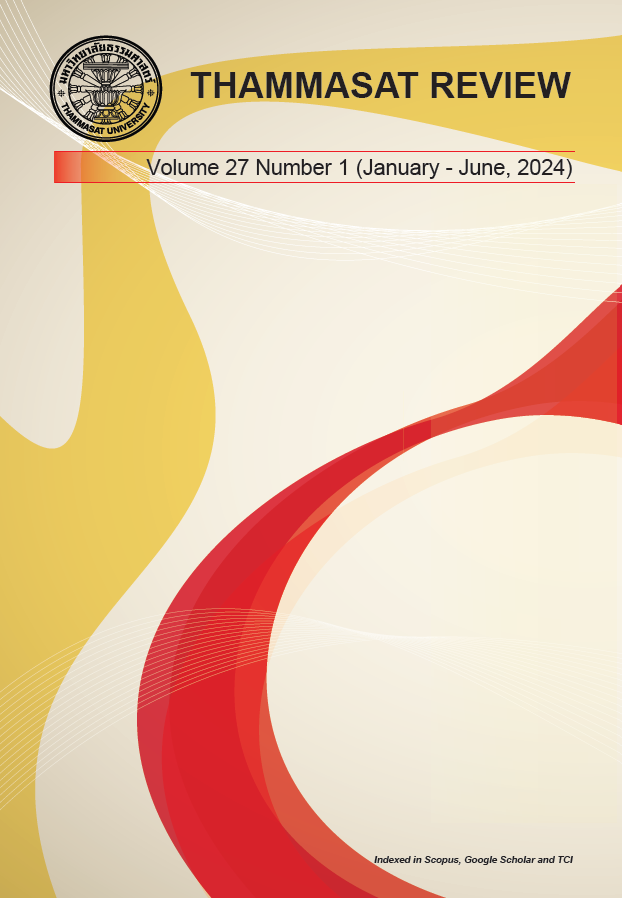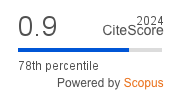Public Opinion Polls in the 2023 Thai General Election: Unanalyzed Demographic Data
Keywords:
Demographic Information, Public Opinion Poll, Pierre Bourdieu, Class, BiasAbstract
By surveying public opinion before and during elections, the results of various polls inform us about the popularity of political parties and candidates, as well as predict the number of seats each political party may secure in the parliament and election outcomes. Surveys are beneficial for polling agencies, mass media, political parties, and candidates, as they provide insight into the preferences and predictions of the electorate. The findings of this study show that the typical opinion poll can fall short of serving the public as owners of sovereignty, as it often neglects to survey policies and issues relevant to the people. Additionally, polls fail to analyze demographic data that could help society understand the origin and trajectory of public opinions, issues, and needs. Economic, social, political, and cultural factors can impact survey results, as explained by Pierre Bourdieu. He elucidated the survey of public opinions and underscored the significance of demographic data analysis with class perspectives. When polling agencies overlook and exhibit bias in their surveys, they assume a guiding role in politics. This is because they prescribe information and the direction of the political situation through various media channels. Such a situation represents symbolic violence. To break free from this, prioritizing the analysis of demographic data and public policies in surveys could redirect attention from the political competition landscape to the issues and needs of the people.
References
Bailey, M. (2023). A new paradigm for polling. Harvard Data Science Review, 5(3), 1-27.
Baum, M. A., & Kernell, S. (2001). Economic class and popular support for Franklin Roosevelt in war and peace. Public Opinion Quarterly, 65(2), 198-229.
Bourdieu, P. (1979). Public opinion does not exist. In A. Mattelart & S. Siegelaub (Eds.), Communication and class struggle volume 1 (pp. 124-129). New York: International General.
Bourdieu, P. (1986). The forms of capital. In J. Richardson (Ed.), Handbook of theory and research for the sociology of education (pp. 280-291). Westport, CT: Greenwood.
Bourdieu, P. (1987). What makes a social class? On the theoretical and practical existence of groups. Berkeley Journal of Sociology, 32, 1-17.
Bourdieu, P. (1991). The craft of sociology. New York: Walter de Gruyter.
Bourdieu, P. (1992). Language and symbolic power. Cambridge: Polity Press.
Bourdieu, P. (1993). Sociology in Question. London: SAGE.
Chatterjee, S., & Kamal, J. (2021). Voting for the Underdog or Jumping on the Bandwagon? Evidence from India’s Exit Poll Ban. Public Choice, 188(3), 431-453.
Clarke, H. D., Goodwin, M., & Whiteley, P. (2017). Brexit: Why Britain voted to leave the European Union. Cambridge: Cambridge University Press.
Dong, X., & Ying, L. (2021). A review of social media-based public opinion analyses: Challenges and recommendations. Technology in Society, 67(C). doi:10.1016/j.techsoc.2021.101724
Evans, G., & Menon, A. (2017). Brexit and British politics. Cambridge: Polity Press.
Farjam, M. (2021). The bandwagon effect in an online voting experiment with real political organizations. International Journal of Public Opinion Research, 33(2), 412–421. Advance online publication. https://doi.org/10.1093/ijpor/edaa008
Fry, J., & Brint, A. (2017). Bubbles, blind-spots and Brexit. Risks, 5(3), 37, 1-15.
Fujiwara, T., Müller, K., & Schwarz, C. (2021). The effect of social media on elections: Evidence from the United States. National Bureau of Economic Research No. w28849. https://ssrn.com/abstract=3856816
Goffman, E. (1951). Symbols of class status. The British Journal of Sociology, 2(4), 294-304.
Goffman, E. (1959). The presentation of self in everyday life. New York: Doubleday Anchor Books.
Han, S., & Kwon, H. Y. (2023). Inequality, social context, and income bias in voting: Evidence from South Korea. International Journal of Public Opinion Research, no 2, 1-12.
Hargittai, E., & Karaoglu, G. (2018). Biases of online political polls: Who participates. Socius: Sociological Research for a Dynamic World, 4, 1-7.
"Kao klai raeng 'photho' so wuet laen salai poet thang 'khua ratthaban' phlik chana" [Powerful for the Move Forward Party come with strength, Pheu Thai's miss, Government's path to victory]. (2023, May 1). Thaipost. https://www.thaipost.net/hi-light/369501/
Kennedy, C., Lopez, J., Keeter, S., Lau, A., Hatley, N., & Bertoni, N. (2021). Confronting 2016 and 2020 polling limitations. Pew Research Center. https://www.pewresearch.org/methods/wp-content/uploads/sites/10/2021/04/PM_04.08.21_polling.limitations.pdf
Kim, S., & Lee, T. (2023). Making opinions public: Polling and democratic responsiveness in South Korea. Politics & Society. https://doi.org/10.1177/00323292231181766
Landreville, K. D., White, C., & Allen, S. (2015). Tweets, polls, and quotes: Gatekeeping and bias in on-screen visuals during the final 2012 presidential debate. Communication Studies, 66(2), 146-164.
Laurison, D. (2016). Social class and political engagement in the United States. Sociology Compass, 10(8), 684-697. https://doi.org/10.1111/soc4.12390
Lindh, A., & McCall, L. (2020). Class position and political opinion in rich democracies. Annual Review of Sociology, 46, 419-441.
Madson, G. J., & Hillygus, D. (2019). All the best polls agree with me: Bias in evaluations of political polling. Political Behavior, 42, 1055-1072.
Morris, J. (2023). Public opinion still does not exist; War in Ukraine and dictatorship in Russia can help us acknowledge that. Russian Analytical Digest, 292, 7-9.
Moy, P., Domke, D., & Stamm, K. (2001). The spiral of silence and public opinion on affirmative action. Journalism & Mass Communication Quarterly, 78(1), 7-25.
Pariser, E. (2011). The filter bubble: What the internet is hiding from you. New York: The Penguin Press.
Pekar, V., Najafi, H., Binner, J. M., Swanson, R., Rickard, C., & Fry, J. (2022). Voting intentions on social media and political opinion polls. Government Information Quarterly, 39(4). https://doi.org/10.1016/j.giq.2021.101658
Shin, J., & Ognyanova, K. (2022). Social media metrics in the digital marketplace of attention: Does journalistic capital matter for social media capital? Digital Journalism, 10(4), 579-598.
Shirani-Mehr, H., Rothschild, D., Goel S., & Gelman, A. (2018). Disentangling bias and variance in election polls. Journal of the American Statistical Association, 113(522), 607-614. https://doi.org/10.1080/01621459.2018.1448823
Skoric, M. M., Liu, J., & Jaidka, K. (2020). Electoral and public opinion forecasts with social media data: A meta-analysis. Information, 11(4), 187. https://scholars.cityu.edu.hk/files/57689326/information_11_00187.pdf
Subeti, D., & Mutiarin, D. (2023). Political polarization in social media: A meta-analysis. Thammasat Review, 26(2), 1-23.
Unkelbach, F., John, M., & Vogel, V. (2023). Jumping on the bandwagon: The role of voters' social class in poll effects in the context of the 2021 German federal election. Polit Vierteljahresschr, 51-78.
Valentino, N. A., Zhirkov, K., Hillygus, S., & Guay, B. (2020). The consequences of personality biases in online panels for measuring public opinion. Public Opinion Quarterly, 84(2), 446-468.
van der Meer, T. W., Hakhverdian, A., & Aaldering, L. (2016). Off the fence, onto the bandwagon? A large-scale survey experiment on effect of real-life poll outcomes on subsequent vote intentions. International Journal of Public Opinion Research, 46-72.
Yudin, G. (2020). Governing through polls: Politics of representation and presidential support in Putin's Russia. Javnost - The Public, 27(1), 2-16.
Downloads
Published
How to Cite
Issue
Section
License
Copyright (c) 2024 Thammasat Review

This work is licensed under a Creative Commons Attribution-NonCommercial-NoDerivatives 4.0 International License.
The opinions and ideas expressed in all submissions published in Thammasat Review are solely that of the author(s) and do not necessarily reflect that of the editors or the editorial board.
The copyright of all articles including all written content and illustrations belong to Thammasat Review. Any individuals or organisation wishing to publish, reproduce and distribute a particular manuscript must seek permission from the journal first.








